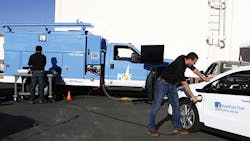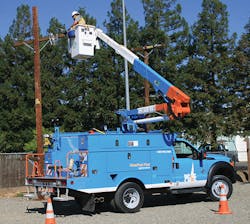Pacific Gas and Electric Co. (PG&E) unveiled two fuel-efficient work trucks in September that promise innovative operation and the use of groundbreaking technology. One truck has the potential to eliminate the need for planned outages and lessen the impact of unplanned ones. The other truck allows the operation of a bucket and other auxiliary systems without requiring the engine to idle.
The vehicles — custom designed and developed by Efficient Drivetrains Inc. (EDI), in partnership with PG&E — are built on the Ford F‐550 platform and integrate exportable power and electric power take-off applications with the innovative EDI-Drive system. EDI-Drive is the first plug-in hybrid electric vehicle (PHEV) drivetrain to feature both parallel and series hybrid modes, allowing the vehicle to maximize fuel efficiency in both highway and in-city driving conditions.
The result is a Class 5 work truck that reduces emissions by 80%, compared to conventional vehicles, and features up to 35 miles (56 km) of all-electric range with 300 miles (480 km) more of driving range in hybrid mode. These vehicles bundle an array of technologies that will help PG&E to reach its goals of electrifying its utility fleet and using onboard generating capability, both of which have the potential to fundamentally change how the utility manages electric outages.
Why Electric?
PG&E has been a pioneer of alternative fuels and operates the greenest utility fleet in the U.S. with more than 3500 alternative fuel vehicles, including nearly 1100 electric, plug-in electric and hybrid units. With a service area that stretches from just north of Los Angeles, California, to Oregon and east to Nevada, there is no single vehicle technology that meets all of PG&E’s operational needs. However, the type of vehicles with the broadest range of applications for PG&E are PHEVs.
Given their extended range, combined with their onboard generating capacity, the utility is especially bullish about implementing increasing numbers of these vehicles into its fleet. The primary reason is emergency-response capability; the vehicles used in that application need to be able to respond anywhere at any time. PHEVs, with their exportable power capacity, have the added potential benefit of being able to provide power to customers during planned and unplanned outages.
In addition, PG&E has moved aggressively to integrate more PHEVs into its fleet because of their reduced operational cost. The utility has found the majority of these vehicles have full payback in less than five years, as a result of their reduced fuel and maintenance costs. Regenerative braking means the brakes on these vehicles last significantly longer, and the overall simplicity of electric hybrid engineering is a key reason for their reduced cost of operation. What’s more, the utility also is exploring the possibility of using the batteries from PHEVs that have reached the end of their operational life for power storage and grid stability, which would make the technology even more practical and help the utility to meet its overall goal of providing safe and reliable service to customers.
The Call for Increased Investment
Based on PG&E’s success in implementing innovative technologies to electrify its fleet, the utility partnered with the Edison Electric Institute (EEI) and Portland General Electric in August 2014 to urge other utilities to more than double their current investments in electric utility fleet vehicles. This goal represents an estimated US$50 million of new investment in electric vehicles across the industry, and it would deliver economic and environmental benefits for utilities and customers.
Over the past five years, the industry has invested approximately $85 million incorporating PHEV technologies into utility fleets, or about 1.7% of overall utility fleet spending. PG&E and EEI are calling on utilities to raise that investment to 5% of their total fleet investment, or approximately $1 billion, starting in 2015.
The industry also is taking new steps to support utilities working to achieve this goal. EEI has formed an electrification task force designed to provide technical expertise as well as share industry best practices and case studies from utilities that have emerged as leaders in fleet electrification. This includes PG&E, which operates the largest fleet of alternative-fuel vehicles in the U.S. and tops the industry with 14% of its fleet investment dedicated to plug-in technologies.
Expanding the use of plug-in technologies is one of the most important opportunities for the U.S. to continue diversifying its energy usage and achieve its clean energy goals. Electrifying utility fleets is about showing consumers plug-in technology is thriving and delivers real benefits that make sense for both utilities and consumers.
Exportable Power Capacity
On the topic of safe and reliable service, one of the most pressing challenges facing PG&E and other utilities in the U.S. is the need to minimize the duration and frequency of power outages. Thus, PG&E has been working with several electric vehicle manufacturers over the past few years to harness the onboard electric generation capacity of plug-in hybrids, with varying degrees of success. Key issues with onboard generation have included adequate cooling capacity, given the limited space typically found in an engine compartment, as well as overall generating capacity.
Early exportable power-capable vehicles — for which PG&E partnered on the development — ranged from 15 kW to 70 kW, well short of the utility’s goal of 120 kW. Given the EDI vehicle features 120 kW of exportable power capacity, the unit is capable of providing full utility-grade power to 80% of the transformers in the utility’s service area, meaning it is rightsized for PG&E’s operational needs.
Why is this important? There are several reasons, including improving the utility’s metrics on the duration and frequency of outages as well as improving disaster-response capability in earthquake-prone Northern California, where PG&E is based. Regarding standard outages, they are either planned for scheduled grid maintenance or unplanned due to failures on the grid.
The utility-grade exportable power featured on the EDI units has the potential to enable PG&E to improve its performance on both of those metrics. Planned outages could be avoided by rolling one of these vehicles into the outage area and plugging it directly into the grid, allowing work to be completed without power being interrupted. Unplanned outages as a result of weather conditions, equipment failure or other causes could be dramatically shortened, as well.
Considering the utility of vehicles with exportable power capability, their application extends well beyond routine, everyday power outages. Imagine having a fleet of these vehicles ready to roll into a disaster-response scenario, such as a Hurricane Sandy or a major earthquake. Power could be restored to many customers prior to the completion of repairs, dramatically lessening the impacts of such events. Why? In situations with widespread outages, like a hurricane or other natural disaster, many of the intermediate lines serving individual homes and businesses are still in place.
What this means is, by plugging a vehicle with 120 kW of exportable power directly into the local grid, whole neighborhoods could be restored prior to the completion of broader grid repairs. In fact, the EDI vehicle is capable of providing power to up to 30 homes during peak usage times and up to 100 homes during off-peak hours. Given that fact, PG&E believes once these vehicles enter production, within a few years, there will be widespread adoption of them by U.S. utilities, which will revolutionize how utilities manage outages and allow them to serve customers better.
Electric Power Take-Off Technology
Another key technology featured on the Class 5 trouble truck model is electric power take-off capability (ePTO). PG&E pioneered the development and use of this technology more than five years ago working with Altec Industries. The utility’s goal in developing this technology was to eliminate the need to idle vehicles while at job sites by allowing all onboard equipment — including the aerial device, tool circuit, lights, climate control and other auxiliary systems — to be operated off of a series of batteries.
There are several benefits of ePTO technology. First, there are reduced noise levels at job sites, allowing crews to perform their work without the need to have a noisy diesel engine idling. This improves job site safety as crews are able to communicate more easily, and residents and businesses in areas where work is taking place also are less impacted, especially during outages occurring at night. Second, the technology dramatically reduces emissions and saves fuel. PG&E currently has more than 350 conventional fuel Class 5 ePTO-equipped units and saved nearly $800,000 in fuel costs in 2014 alone using this technology.
The new Class 5 trouble truck units from EDI feature ePTO technology on a PHEV vehicle with an all-electric range of up to 35 miles, which will help PG&E to reduce fuel costs even more when combining the two technologies. Overall, PG&E currently operates 942 Class 5 vehicles, including bucket trucks, flatbeds and other service trucks. If the utility were to replace all of those vehicles with EDI’s plug-in electric hybrid models, PG&E would save nearly $3.5 million in fuel costs and reduce greenhouse gas emissions by more than 9000 metric tons annually.
Win, Win, Win
Looking at the combination of vehicle technologies on the EDI units, with more than 30 miles (48 km) of electric range, ePTO and 120 kW of exportable power, PG&E crews can drive to a job site, synchronize power from the truck’s battery with the grid, begin exporting power and disconnect the transformer for maintenance — all with no interruption to service, zero job site engine idling and no noise, fumes or greenhouse gas emissions. Once maintenance is complete, the technicians simply reconnect the local transformer. Residents will never even know the service truck was in the neighborhood.
David Meisel ([email protected]), senior director of transportation and aviation services, leads Pacific Gas and Electric Co.’s transportation services organization and its more than 420 employees, where he manages a fleet of nearly 15,000 vehicles. His responsibilities include garage operations at 68 locations, fleet acquisition and disposition, fleet engineering, aircraft and helicopter operations, Department of Transportation regulatory compliance and the fleet information technology organization.
Mentioned in this article:
Altec Industries | www.altec.com
Efficient Drivetrains Inc. | www.efficientdrivetrains.com
Edison Electric Institute | www.eei.org
Pacific Gas and Electric Co. | www.pge.com
Portland General Electric | www.portlandgeneral.com


